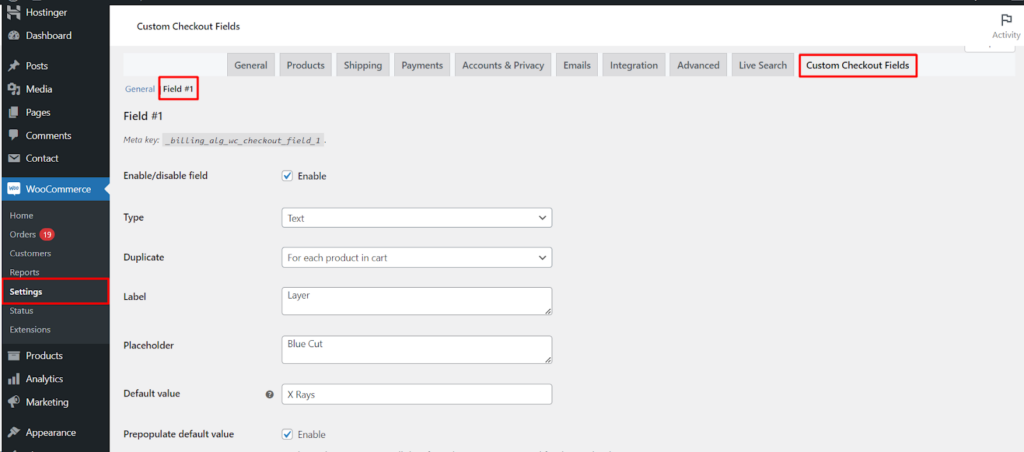The Custom Checkout Fields for WooCommerce plugin empowers you to personalize the checkout experience by adding custom fields. This guide delves into the configuration options available for each individual custom field, allowing you to define its functionality, appearance, and data collection behavior within your WooCommerce store.
Accessing Field Configuration
With the plugin activated, follow these steps to access the configuration options for an individual custom field.
- Navigate to WooCommerce: Within your WordPress dashboard, locate the WooCommerce menu and click on it.
- Access Settings: Click on Settings within the WooCommerce menu.
- Find Custom Checkout Fields: Look for a section labeled Custom Checkout Fields (or similar wording based on your plugin version). Click on it to access the plugin’s settings.
- General Tab (Optional): You might need to define the total number of custom fields in the General tab first (refer to our previous guide on setting the number of fields).
- Individual Field Tabs: After setting the number of fields, you’ll see separate tabs for each field (e.g., Field #1, Field #2, etc.). Click on the relevant field tab to configure its specific settings.
Understanding Field Configuration Options
Each field tab offers a comprehensive set of options for defining your custom field’s behavior.
- Enable/Disable Field: This toggle allows you to activate or deactivate the field on your checkout page.
- Type: Choose the type of field that best suits the information you want to collect. Common options include Text, Textarea, Number, Checkbox, Datepicker, and more.
- Duplicate (Optional): Some plugins allow you to define how the field behaves when multiple products are in the cart. You can choose not to duplicate, duplicate for each product, or duplicate for each product item.
- Label: Enter a clear and concise label that appears next to the field, guiding the customer on what information to enter.
- Placeholder (Optional): Provide a placeholder text displayed within the field to guide the customer further.
- Default Value (Optional): Set a default value that pre-populates the field, potentially offering a starting point for the customer.
- Prepopulate Default Value (Enable/Disable): This option determines whether the default value is automatically filled in or remains for reference.
- For Logged-in Customers, Pull Data from Their Account (Enable/Disable): (Not applicable for Multiselect) This setting allows you to automatically populate the field with data from the customer’s account if they are logged in.
- Description (Optional): Provide additional information about the field’s purpose or usage.
- Required (Enable/Disable): Mark this checkbox to make the field mandatory for users to complete the checkout process.
- User Profile (Add/Remove): (Not applicable for Multiselect) This option allows you to add the field to your customer’s profile page, potentially pre-populating it with their information on future purchases.
Additional Considerations
The specific options available might vary depending on your chosen plugin. Explore the plugin’s documentation for a comprehensive understanding of its functionalities.
Benefits of Configured Custom Fields
By strategically configuring individual custom fields, you can achieve several benefits.
- Gather Specific Information: Collect the precise data you need from your customers to fulfill orders or personalize marketing strategies.
- Streamlined Checkout: Pre-populating fields or setting defaults can expedite the checkout process for customers.
- Improved User Experience: Clear labels, placeholders, and descriptions ensure customers understand what information is required and how to provide it.